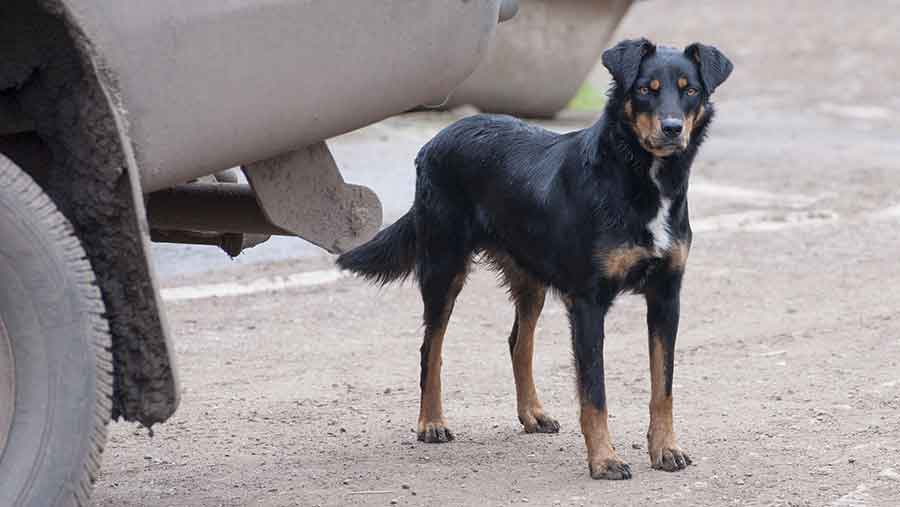More farmers look to NZ Huntaway dog to work sheep
 © John Eveson/FLPA/Rex Shutterstock
© John Eveson/FLPA/Rex Shutterstock Black and tan, smooth-coated and powerfully built, the New Zealand Huntaway may be a far cry from the norm when considering a sheepdog, but increasing numbers of UK farmers are finding looks can be deceptive. Jeremy Hunt reports.
At first glance the Huntaway dog could be mistaken for a cross-bred Labrador, but when it comes to moving sheep, devotees say the breed is unbeatable.
The highly intelligent and energetic breed is primarily trained to use repetitive barking to drive sheep. However, it has also been successfully trained to respond to conventional whistle commands in addition to using their bark.
Mid-Wales breeder Brian Davies from Brecon brought the first Huntaways to the UK in 1975 – and he’s still deeply committed to the breed.
See also: Which working dog to choose
“Once you’ve had one you would never want to be without one.
“There’s a huge future for these dogs in the UK because the quad bike has changed the way we gather sheep. Most sheep farmers now use the bike to race to the farthest point behind the sheep and then drive them home.
Training tips (provided by breeder Brian Davies)
- A young Huntaway pup of around three months old can be taught the two basic commands that are the foundation of its herding skills – “speak up” and “quiet”.
- Encourage Huntaways to bark with the words “speak up” and to stop with the command “quiet”
- Dogs should be able to respond to command words before being introduced to sheep
- By six or seven months old a Huntaway can be introduced to sheep
- No whistle commands are needed
- Start working a youngster with some lambs or smaller sheep. By 12 months old they should be able to work 500 sheep.
Huntaway facts
- Pups registered with the New Zealand Sheep Dog Association cost about £500 for bitches and £400 for dogs.
- Huntaways stand at around 29in at the shoulder and can weigh up to 40kg
- Cross breeding not advised. Find out about the animal before purchasing
- Huntaways can easily work 1,000 sheep
- Can also work with dairy cows
“And the dogs that best fit this style of shepherding are Huntaways – that’s where they get their name from because they hunt-away,” says Mr Davies.
New Zealand farmers use the Huntaway because they require a dog that can work sheep by barking, mainly because their Romneys have a lot of wool over their face and respond more to noise than to the sight of a dog.
And because they want dogs that work independently and long distances away from them, they have to be totally trustworthy, explains Mr Davies.
“This is a trait that is still maintained in the Huntaway, which is renowned for its gentle and reliable temperament, particularly when around children,” he adds.
Huntaway benefits
Cumbria sheep farmer Steadman Dodd and his wife Judy have been working with Huntaways for more than 20 years and say they can’t imagine farming without them.
“These dogs are tremendous for driving sheep, and in particular when we have to use the lanes around the farm,” says Mr Dodd.
The couple now have three Huntaways – a four-year-old bitch and two of her two-year-old progeny.
“Once these dogs have grasped what you want them to do they are very easy to work with.
“We do have to move sheep on the roads from time to time, but I can take newly weaned lambs and I can guarantee she won’t let one lamb stray into a garden. I can start her barking when I want to and I can stop her just as easily. It’s like flicking a switch.”
Training
The Dodds have taken their Huntaway training to a new level and have managed to train one of the younger dogs to gather as well as to drive.
“We start with some easy training at around eight months old, just taking it steadily. They instinctively move backwards and forwards when they’re working but I’ve now started to use some whistle commands, so I can move them and stop them just as I want to.”
Mr Dodd says he’s never had dogs that can drive sheep and move them through pens or shedders like Huntaways.
“They are outstanding working dogs. They run for fun, never tire and just get on with the job until it’s done. They don’t frighten the sheep, they just walk among them as if they are another sheep and that keeps them moving.
“In fact the older bitch has taught herself to use her shoulders to push sheep forward,” he adds.
